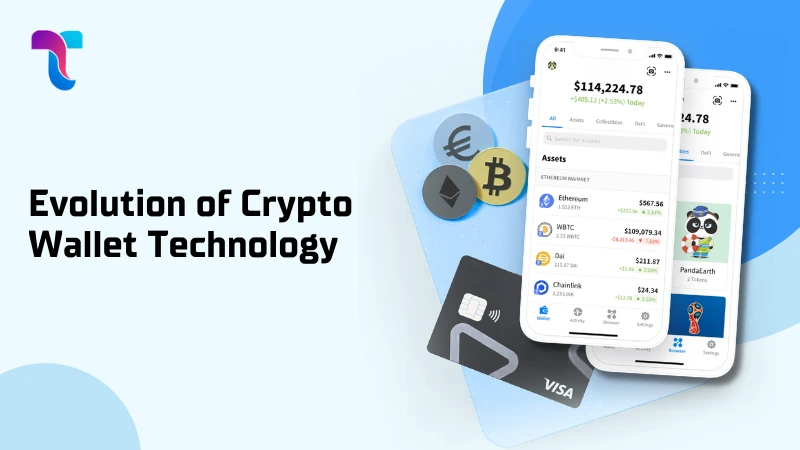Can you carry your entire bank in your pocket? Sounding stupid, right?
Let’s change the question! Can you carry your entire bank in your pocket, but instead of cash or cards, it is digital assets? What are your thoughts on this? Sounds futuristic? Not anymore!
Back in 2013, crypto wallets were clunky, confusing, and mostly used by only Bitcoin enthusiasts. Fast forward to 2025, and they have evolved into sleek, secure, user-friendly tools that millions rely on daily.
So, how did we get here? Interested to learn about this? Well, that’s what this blog is all about!
In this blog, we’ll take you on a journey through the evolution of crypto wallets, from how we went from basic desktop to smart crypto wallets integrated with DeFi, NFTs, and even AI.
Without further delay, let’s have a look at the history of crypto wallets!
Basics of Crypto Wallets
Before exploring how crypto wallets have evolved from 2013 to 2025, it is important to understand what they are.
A crypto wallet is a digital tool that is used to store and manage private keys. Well, private keys are the credentials that allow you to access and control your cryptocurrencies.
Contrary to popular belief, wallets don’t hold the actual coins. Instead, they protect the keys that unlock access to coins stored on the blockchain.
If you’re planning to build your own crypto wallet, it’s important to first understand the fundamentals of how wallets actually work.
Well, there are two basic types of crypto wallets, including:
- Hot Wallets
Introduced early in crypto history, hot wallets are connected to the internet. They became popular for ease of access and fast transactions, but are more vulnerable to hacking and phishing, especially in the early days (2013–2017).
- Cold Wallets
Developed to counter online threats, cold wallets store private keys offline. Hardware wallets gained popularity after several high-profile exchange hacks. While less convenient, they became the gold standard for long-term crypto storage by 2020 and beyond.
Snapshot Timeline of Crypto Wallet Technology Evolution (2013–2025)
Before we get into details, let’s take a sneak peek at the evolution of cryptocurrency wallets!
| Year/Period | Wallet Type | Key Features | Limitations |
| 2013–2015 | Desktop & Paper Wallets |
|
|
| 2015–2017 | Mobile & Web Wallets |
|
|
| 2016–2018 | Hardware Wallets |
|
|
| 2018–2020 | Multi-Currency & Cross-Chain Wallets |
|
|
| 2020–2022 | Smart Contract & DeFi Wallets |
|
|
| 2022–2023 | Security Enhancements & Social Recovery |
|
|
| 2023–2025 | MPC & Account Abstraction Wallets |
|
|
| 2025 & Beyond | AI-Integrated & Encrypted Wallets |
|
|
Rise of Mobile & Web Wallets (2015–2017)
As Bitcoin and altcoins gained popularity, crypto wallets began adapting to modern user behavior. Mobile crypto wallets like Breadwallet, Mycelium, and Electrum brought crypto to smartphones. Web crypto wallets such as Blockchain.info and exchange wallets have also made it even easier to get started. This era even introduced the custodial vs. non-custodial debate. Custodial wallets handled your keys for you, while non-custodial wallets let you manage your own keys.
Hardware Wallet Revolution (2016–2018)
With rising values came new concerns: security. The rise in exchange hacks pushed users to seek safer storage solutions. That’s when hardware crypto wallets like Ledger, Trezor, and KeepKey were introduced. These devices securely store private keys offline, which protects assets from malware and phishing attacks.
The concept of cold vs. hot wallets became more important. Cold wallets (that are offline) became the gold standard for long-term storage, while hot wallets (that are online) served for daily use.
Multi-Currency & Cross-Chain Wallets (2018–2020)
In 2018, the crypto landscape was no longer limited to just Bitcoin. There were other altcoins like Ethereum, Litecoin, and more that gained momentum. Some of the other best crypto wallets, such as Trust Wallet, MetaMask, and Exodus, expanded to support multiple assets across chains, which were referred to as multi-currency crypto wallets.
Smart Contract & DeFi Wallets (2020–2022)
This era marked the rise of DeFi, which was associated with wallets. During that time, MetaMask became the default browser extension for DeFi and NFT platforms. Wallets like Argent and Rainbow introduced staking, token swaps, yield farming, and governance.
Security Enhancements & Social Recovery (2022–2023)
As wallet usage grew, this resulted in an increase in scams, phishing, and accidental losses. That gave rise to social recovery wallets like Argent, which allowed users to regain access through trusted contacts. Other than that, multi-signature wallets were also introduced, which became a standard for DAOs, which required multiple approvals for transactions.
Next-Gen Wallets: MPC & Account Abstraction (2023–2025)
We are now entering the era where security and usability are highly prioritized. Multi-Party Computation or MPC crypto wallets eliminate seed phrases by splitting keys among multiple parties. Another one is account abstraction wallert, which allows smart wallets to automate gas fees and set spending rules.
End-to-End Encryption & AI Integration (2025 & Beyond)
In 2025, crypto wallets are evolving with end-to-end encryption for enhanced privacy and AI integration for real-time fraud detection and transaction monitoring. AI also enables smart features like portfolio rebalancing, scam detection, and automated compliance (KYC/AML). These innovations make wallets more secure and user-friendly. Thus, we can say that the future of crypto wallets is smarter and safer.
It’s a Wrap
That’s it for this blog!
The evolution of crypto wallets has been marked by significant advancements in security, functionality, and user experience. From the early days of paper wallets to smart wallets of today, crypto wallets have evolved in various forms.
We hope this blog gave you valuable insights into how far crypto wallet technology has come and where it is headed next.
At Technoloader, we stay at the forefront of blockchain and crypto innovation. Our team of experts can help you build your own crypto wallet and can turn your vision into reality.
Get in touch with us to get started!
 +91 7014607737
+91 7014607737
 info@technoloader.com
info@technoloader.com



